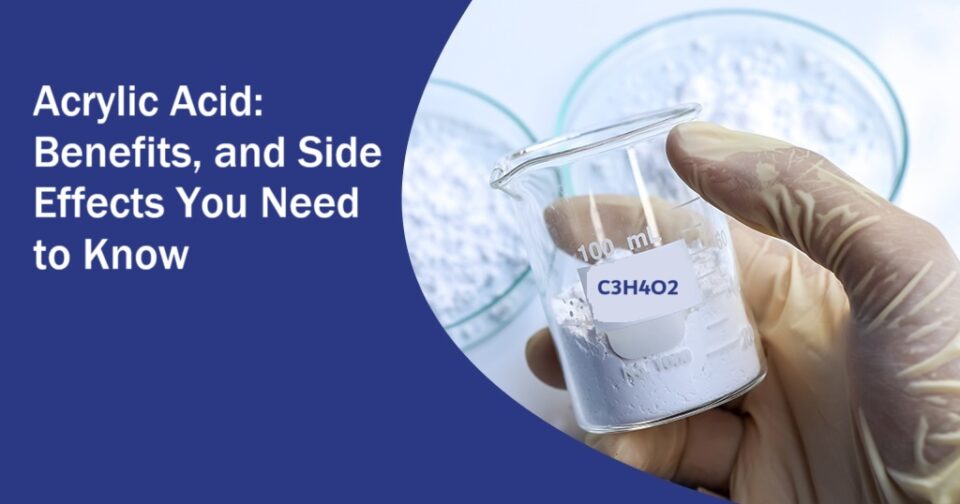Acrylic acid is a key chemical compound used in the production of various polymers and resins, making it an essential component in numerous industries. Its widespread applications range from adhesives and paints to personal care products. However, despite its versatility, Acrylic acid 99.5% also poses certain risks, particularly in terms of health and safety. In this article, we will explore the benefits and potential side effects of acrylic acid, helping you better understand its uses and the precautions necessary when working with it.
Table of Contents
What is Acrylic Acid?
Acrylic acid (C3H4O2) is an unsaturated carboxylic acid that is used primarily as a building block for creating polymers. It is a colorless liquid with a strong, pungent odor and is highly reactive, making it ideal for producing a wide variety of materials such as plastics, paints, adhesives, coatings, and textiles. Acrylic acid is most often used in the form of derivatives like acrylates and polyacrylic acid, which are safer and more stable for consumer and industrial applications.
Benefits of Acrylic Acid
Versatile Industrial Applications: Acrylic acid is a critical component in producing superabsorbent polymers (SAPs), which are widely used in products like diapers, hygiene products, and absorbent pads. It is also a key ingredient in adhesives, sealants, coatings, and paints, contributing to the performance of products used in construction, packaging, and textiles.
Water-Absorbing Properties: When polymerized, acrylic acid creates substances that can absorb and retain large amounts of water. This property makes it invaluable in products like diapers and other absorbent materials, providing improved moisture management.
Improves Product Durability: It-based polymers enhance the durability and flexibility of products such as paints, coatings, and adhesives. They contribute to weather resistance and mechanical strength, making them suitable for outdoor and industrial use.
Increased Adhesion: To enhance adhesion in various materials, making it a key component in pressure-sensitive adhesives (PSAs) used in tapes, labels, and medical dressings. This quality also makes it useful for bonding surfaces in the construction and packaging industries.
Environmental Benefits: It is a building block for producing biodegradable polymers that are more eco-friendly alternatives to traditional plastics. These biodegradable materials are being increasingly used to reduce environmental impact, particularly in packaging and single-use products.
Side Effects of Acrylic Acid
While acrylic acid offers numerous benefits, there are potential side effects and health risks associated with its handling and exposure, particularly in its raw, unpolymerized form.
Skin and Eye Irritation: Direct contact with acrylic acid can cause significant irritation to the skin and eyes. Prolonged exposure may result in burns, redness, or dermatitis. Protective gear, such as gloves and goggles, is recommended when handling this chemical to avoid accidental contact.
Respiratory Issues: Inhalation of acrylic acid fumes or vapors can irritate the respiratory tract, leading to coughing, sore throat, and shortness of breath. In cases of high exposure, it can cause more severe conditions, such as chemical pneumonitis or pulmonary edema. Adequate ventilation is essential when working with this substance to minimize the risk of inhaling harmful vapors.
Corrosive Effects: Acrylic acid is corrosive in its liquid form and can damage surfaces, equipment, or tissues upon contact. In industrial settings, handling this chemical requires careful storage and transportation to prevent leaks or spills that could lead to hazardous exposure.
Allergic Reactions: Some individuals may develop an allergic reaction to acrylic acid after repeated exposure, especially if it comes into contact with the skin. Symptoms may include redness, itching, swelling, or more serious allergic dermatitis.
Long-Term Health Risks: Prolonged or repeated exposure to acrylic acid, particularly in high concentrations, may pose long-term health risks. Studies suggest that chronic exposure could potentially affect kidney function or the nervous system, although more research is needed in this area.
Environmental Concerns: Acrylic acid, when released into the environment in large amounts, can be harmful to aquatic life. It is classified as toxic to certain organisms, and care must be taken to prevent spills or leaks that could contaminate water bodies.
Safety Measures for Handling Acrylic Acid
Personal Protective Equipment (PPE): Always use proper PPE, including gloves, safety goggles, and protective clothing, when working with acrylic acid to prevent skin and eye contact.
Ventilation: Ensure proper ventilation in workspaces where acrylic acid is used, especially in industrial or laboratory settings, to reduce the risk of inhaling harmful fumes.
Storage: Store acrylic acid in a cool, dry, well-ventilated area, away from heat sources or open flames, as it is flammable in certain conditions.
First Aid: In case of accidental exposure, immediately wash the affected area with plenty of water. Seek medical attention if irritation persists or if more serious symptoms, such as breathing difficulties, occur.
Conclusion
Acrylic acid is a versatile compound with a wide range of industrial applications, from superabsorbent materials to durable adhesives and coatings. However, despite its numerous benefits, it also poses certain health and safety risks, particularly when handled in its raw form. By understanding the potential side effects and taking appropriate safety measures, you can minimize the hazards associated with acrylic acid and safely harness its valuable properties in various applications.

